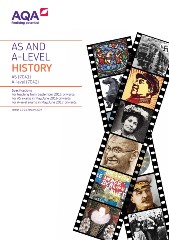Specification at a glance
Subject content
Component 1: Breadth study
1A The Age of the Crusades, c1071–1204
1B Spain in the Age of Discovery, 1469–1598
1C The Tudors: England, 1485–1603
1D Stuart Britain and the Crisis of Monarchy, 1603–1702
1E Russia in the Age of Absolutism and Enlightenment, 1682–1796
1F Industrialisation and the people: Britain, c1783–1885
1G Challenge and transformation: Britain, c1851–1964
1H Tsarist and Communist Russia, 1855–1964
1J The British Empire, c1857–1967
1K The making of a Superpower: USA, 1865–1975
1L The quest for political stability: Germany, 1871–1991
Component 2: Depth study
2A Royal Authority and the Angevin Kings, 1154–1216
2B The Wars of the Roses, 1450–1499
2C The Reformation in Europe, c1500–1564
2D Religious conflict and the Church in England, c1529–c1570
2E The English Revolution, 1625–1660
2F The Sun King: Louis XIV, France and Europe, 1643–1715
2G The Birth of the USA, 1760–1801
2H France in Revolution, 1774–1815
2J America: A Nation Divided, c1845–1877
2K International Relations and Global Conflict, c1890–1941
2L Italy and Fascism, c1900–1945
2M Wars and Welfare: Britain in Transition, 1906–1957
2N Revolution and dictatorship: Russia, 1917–1953
2O Democracy and Nazism: Germany, 1918–1945
2P The Transformation of China, 1936–1997
2Q The American Dream: reality and illusion, 1945–1980
2S The Making of Modern Britain, 1951–2007
2T The Crisis of Communism: The USSR and the Soviet Empire, 1953–2000
Component 3: Historical Investigation
AS
AS students must take assessments in both of the following components, in the same series.
- Component 1: Breadth study
- Component 2: Depth study
Students must:
- study the history of more than one country
- study a British history option for Component 1 or 2
- study a non-British history option for Component 1 or 2
Assessments
| Component 1: Breadth study |
|---|
What's assessed The first part of the corresponding full A-level option. This involves the study of significant historical developments over a period of around 50 years and associated historical interpretations. |
Assessed
|
Questions
|

| Component 2: Depth study |
|---|
What's assessed The first part of the corresponding full A-level option. This involves the study in depth of a major historical change or development and associated primary evidence |
Assessed
|
Questions
|
Prohibited Combinations
Students must study a British history option for either Component 1 or Component 2. If a British history option is chosen for Component 1, it must be combined with a non-British option for Component 2. If a British history option is chosen for Component 2, it must be combined with a non-British option for Component 1. Any British option may be combined with any non-British option.
The following are designated British history options:
Component 1
1C The Tudors: England, 1485–1547
1D Stuart Britain and the Crisis of Monarchy, 1603–1649
1F Industrialisation and the People: Britain, c1783–1832
1G Challenge and Transformation: Britain, c1851–1914
1J The British Empire, c1857–1914
Component 2
2A Royal Authority and the Angevin Kings, 1154–1189
2B The Wars of the Roses, 1450–1471
2D Religious Conflict and the Church in England, c1529–c1547
2E The English Revolution, 1625–1642
2M Wars and Welfare: Britain in Transition, 1906–1929
2S The Making of Modern Britain, 1951–1979
A-level
A-level students must take assessments in all three of the following components in the same series:
- Component 1: Breadth study
- Component 2: Depth study
- Component 3: Historical investigation (Personal study)
Students must:
- study the history of more than one country
- study a British history option for Component 1 or 2
- study a non-British history option for Component 1 or 2
- study topics from a chronological range of at least 200 years
Assessments
| Component 1: Breadth study |
|---|
| What's assessed The study of significant historical developments over a period of around 100 years and associated interpretations. |
| Assessed
|
| Questions
|

| Component 2: Depth study |
|---|
| What's assessed The study in depth of a period of major historical change or development and associated primary evidence. |
| Assessed
|
| Questions
|

| Component 3: Historical investigation |
|---|
| What's assessed A personal study based on a topic of student's choice. This should take the form of a question in the context of approximately 100 years. It must not duplicate the content of options chosen for Components 1 and 2. |
| Assessed
|
- Through the topics studied in Components 1, 2 and 3 (Historical investigation), A-level students must cover a chronological range of at least 200 years.
Prohibited Combinations
Students must study a British history option for either Component 1 or Component 2. If a British history option is chosen for Component 1, it must be combined with a non-British option for Component 2. If a British history option is chosen for Component 2, it must be combined with a non-British option for Component 1. Any British option may be combined with any non-British option, other than the following:
- 1C The Tudors may not be combined with 2C The Reformation in Europe
- 1D Stuart Britain and the Crisis of Monarchy may not be combined with 2F The Sun King: Louis XIV, France and Europe
This is because there is a strong conceptual emphasis which runs across both breadth and depth options which would result in a narrowing of the student’s experience.
The following are designated British history options:
Component 1
1C The Tudors: England, 1485–1603
1D Stuart Britain and the Crisis of Monarchy, 1603–1702
1F Industrialisation and the People: Britain, c1783–1885
1G Challenge and Transformation: Britain, c1851–1964
1J The British Empire, c1857–1967
Component 2
2A Royal Authority and the Angevin Kings, 1154–1216
2B The Wars of the Roses, 1450–1499
2D Religious Conflict and the Church in England, c1529–c1570
2E The English Revolution, 1625–1660
2M Wars and Welfare: Britain in Transition, 1906–1957
2S The Making of Modern Britain, 1951–2007
